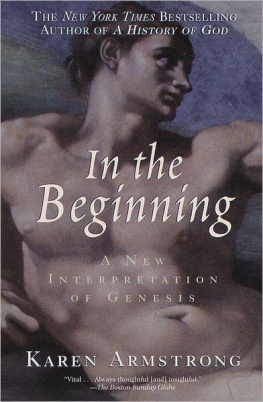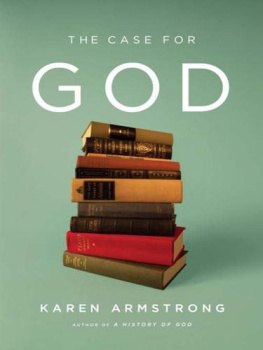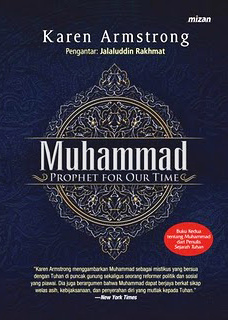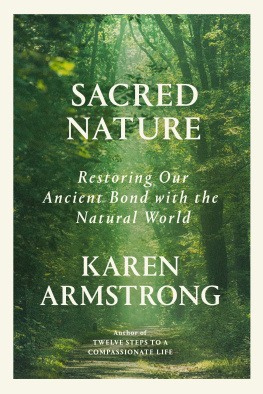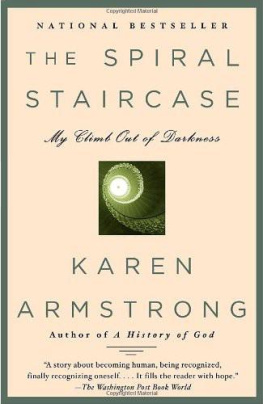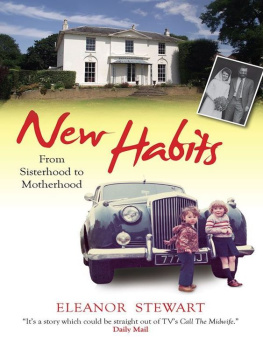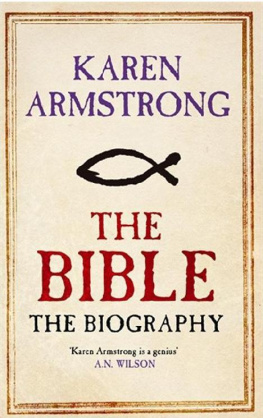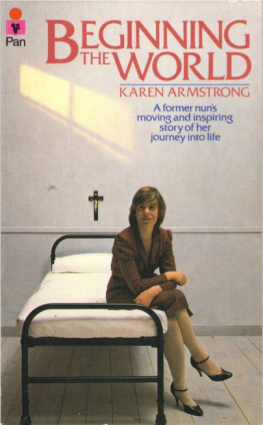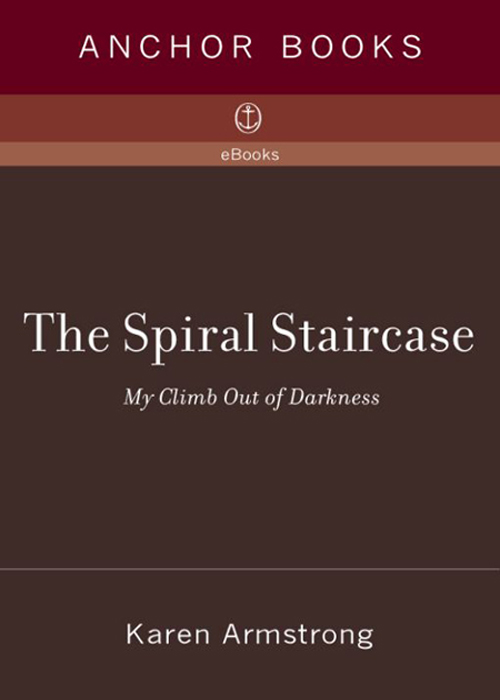

Table of Contents
International acclaim for Karen Armstrongs
THE SPIRAL STAIRCASE
A powerful memoir.... Buoyed by keen intelligence and unflinching self-awareness and honesty.... Armstrong is an engaging, energetic writer. The Christian Science Monitor
A minor masterpiece. Elle
Exceptionally impressive.... Karen Armstrongs account of her spiraling journey provokes thought and inspires respect. The Daily Telegraph
The story of the making of a writer.... It manages to dramatize the writers process of intellectual development and to find in it genuine interest, and, indeed, suspense.... As an account of the intellectual journey of an intelligent and unique individual, the book is often gripping. San Francisco Chronicle
Candid and compelling, and the sentences are flawless. The Dallas Morning News
Unputdownableabsorbing, moving. Daily Mail
Remarkable.... Unflinching.... This candid memoir will clarify thinking about the search for the sacred. Booklist
Gripping.... Uplifting.... Utterly compelling. Edmonton Journal
Armstrong writes with sensitivity and wisdom.... She employs a breadth of learning that reflects the scintillating, shifting light and shade of human experience. The Times (London)
Absorbing.... Profoundly inspiring and engaging. Tallahassee Democrat
An honest and affecting book. The Independent
The Spiral Staircase... is great. Armstrong is a marvelous writer and her subject matter is meaty. Her subject is the meaning of life. Deseret Morning News
Open and accessible, Armstrong manages to put into words something that most of us cannot express. New Statesman
Moving, insightful.... Compulsively readable. Library Journal
A subtle and funny memoir. The Sunday Telegraph
PREFACE
This is the sequel to my first book, Through the Narrow Gate, which told the story of my seven years as a Roman Catholic nun. I entered my convent in 1962, when I was seventeen years old. It was entirely my own decision. My family was not particularly devout, and my parents were horrified when I told them that I had a religious vocation. They thought, quite correctly as it turned out, that I was far too young to make such a momentous choice, but they allowed themselves to be persuaded because they wanted me to get it out of my system as soon as possible. I was usually quite a biddable child but I was anxious to test my vocation immediately, instead of waiting until after I had been to university, as my parents would have preferred. My unusual resolution in the face of their opposition impressed them, and they feared that I might spend my college years in a state of mulish obstinacy, failing to make the most of the opportunities of university life and longing for it all to be over so that I could do what I really wanted. So on September 14, 1962, I packed my bags and joined twelve other girls at the novitiate.
Why was I so determined to take this step? The motivation behind this type of decision is always complex, and there were a number of interlocking reasons. It is true that at this time I was very shy and worried about the demands of adult social life, but even though the religious life might seem a soft option, it was tough, and I would not have lasted more than a few weeks if it had simply been a means of escape. I wanted to find God. I was filled with excitement and enthusiasm on that September day, convinced that I had embarked on a spiritual quest, an epic adventure, in the course of which I would lose the confusions of my adolescent self in the infinite and ultimately satisfying mystery that we call God. And because I was only seventeen, I imagined that this would happen pretty quickly. Very soon I would become a wise and enlightened woman, all passion spent. God would no longer be a remote, shadowy reality but a vibrant presence in my life. I would see him wherever I looked, and I myself would be transfigured, because, as Saint Paul had said, my puny little ego would disappear and Christ, the Word of God, would live in me. I would be serene, joyful, inspired, and inspiringperhaps even a saint.
This was, to put it mildly, an eccentric career option. I was almost the first student of my convent high school to become a nun. Birmingham, my hometown, was a materialistic place, where money was king. Most of my immediate family and friends were nonplussedeven slightly irritatedand I, of course, reveled in the sense of striking out and being just that little bit different. But I may have been more in tune with my times than I realized, since many of my generation, born in the last years or in the immediate aftermath of the Second World War, had the same inchoate yearning for transformation. Postwar Britain was not an easy place to grow up. We may have defeated Hitler, but the war had ruined us. Britain was now a second-rate power, and food, clothing, and petrol were strictly rationed well into the 1950s. Because thousands of homes had been destroyed during the blitz, there was a grave housing crisis. Our cities were scarred with desolate bomb sites and filled with towering heaps of rubble. The center of Birmingham was not completely rebuilt until after I left for the convent. After the war, we were in debt to the United States for 3 billion pounds, our empire was dismantled, and though we were fed on a surfeit of films celebrating Britains endurance and victory, nobody seemed prepared to look facts in the face and decide what our future role in the world should be. Young Britons, like myself, who came to maturity in this twilight confusion of austerity, repression, nostalgia, frustration, and denial wanted not only a different world but to be changed ourselves.
In 1948, 60 percent of British people under thirty wanted to emigrate. We wanted to be somewhere else. Hence (as the music historian Jon Savage explains) the quasi-religious fervor inspired by the rock n roll records that fell like manna from heaven between 1954 and 1959 on a country that had no tradition of Afro-American music. It seemed to promise a new world. The unabashed rebellion and sexual explosiveness of these records was so transforming that nobody who heard them could find a language to explain them except in the phrases of the songs themselves, which talked in tongues: A Wop Bop A Loo Bop, Be Bop A Lula. People used to say of a record, It sent me! as though they had been magically transported, without any effort of their own, to another place. In the world conjured up by rock n roll, nobody had to do national service or listen to endless stories about the war. People could reject the self-sacrifice preached by their parents, live intensely, run wild, have sex, consume freely, and do as much as they could as soon as they could.
This might seem a far cry from the convent. But in my own way, I shared what Savage calls the first time intensity of my generation. The raw, disturbing beat of rock n roll had penetrated my convent school, even though I was neither able nor equipped to answer its summons. I did not like being a teenage girl in the 1950s. I was awkward, plain, bookish, and unpopular with boys. I looked absurd in the fashions of the day: the wide, swirling skirts, pert ponytails, and back-combed beehives. In 1961, the year before I entered the convent, my parents tried to entice me from my intended course by talking me into joining a young peoples group at the Birmingham Catholic Ball. It was a ghastly affair. Encased in a stiff brocaded dress with a skirt that stuck out aggressively, my feet squeezed into an agonizing pair of pink satin shoes with long pointed toes, I was hobbled. On the few occasions when I was invited to dance, and grimly quickstepped, waltzed, and fox-trotted with a herd of others, I felt like a prisoner going round and round the exercise yard. At one point my partner and I left the main room and for ten blissful minutes managed to escape. We werent doing anything unlawful; we werent smoking, drinking alcohol, or kissingjust sitting on the stairs and talkingbut a friend of my mothers pounced on me and frog-marched me back into the ballroom. I felt like a Victorian girl who had been compromised in some way. There had to be more to life than this.
Next page

